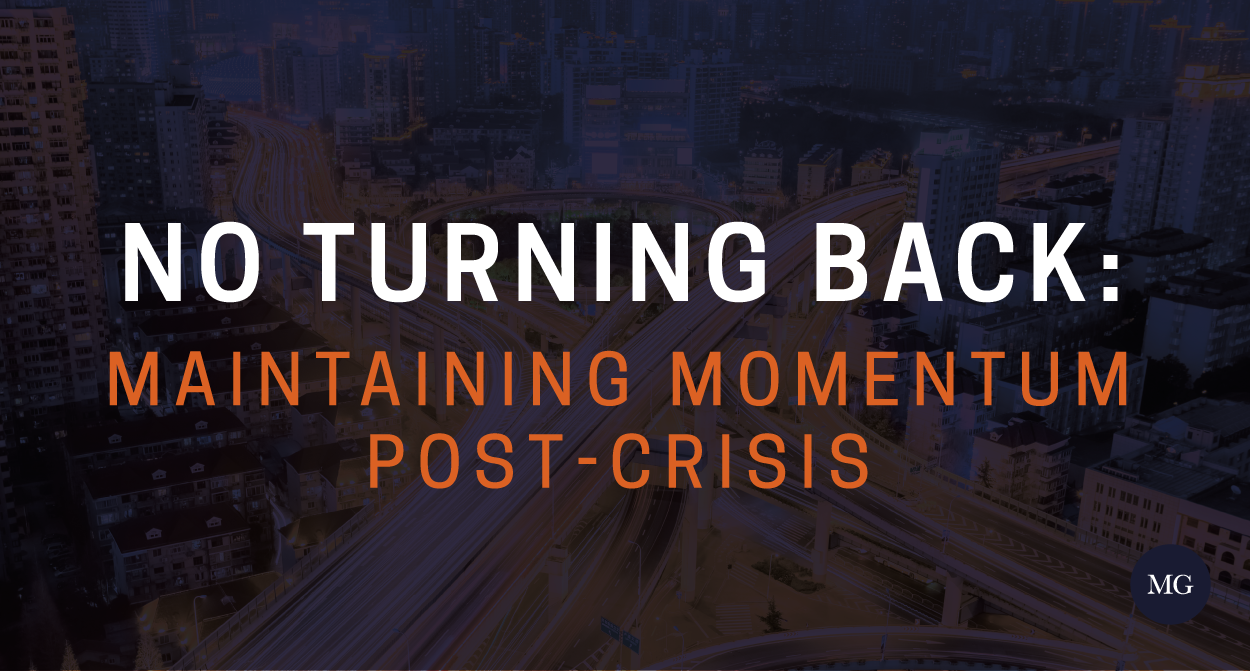Over the past two months, McChrystal Group has heard a similar refrain when speaking with executives at the companies we work with: “Our teams have risen to the occasion in this crisis. Teamwork is at an all-time high. The politics have fallen out of the organization because of the intensity of the situation.”
But after the moment of pride comes the question each CEO has. “How do we maintain this type of mentality when this crisis passes – whenever that might be?”
The quip from former Chicago mayor Rahm Emmanuel “you never want to let a serious crisis go to waste” has become ubiquitous these past two months in corporate circles. But that keeps the framing on the crisis itself as an inflection point; what comes after the inflection point – the months, the years, of hard transformational work – is still ahead of us, undefined.
In moments of crisis, action at the frontlines is often a result of two key drivers: 1) Clarity of mission and 2) transparency of communication. When a building is on fire, the mission is to get people out and control the fire, and alarms throughout the building will communicate the situation. Everything else falls to the wayside until the existential threat subsides. In today’s environment, your mission may be to simply save the organization, and you’re likely communicating that with speed and intensity through multiple platforms to large numbers within your organization. Suddenly every employee clearly understands the goal and reorients their behavior to support the mission.
If I’m on the front line of your company, and I’m hearing from you, my senior leadership, multiple times per week and you’re providing clear and simplified goals to get through the Spring and Summer months, I feel more empowered to take action. You’re letting me into your head, and I’ve quickly developed an understanding of how you see the problem, and what type of actions you think can get us through this phase. The positive momentum that many leaders are describing today is not simply the adrenaline of the crisis, but the sustained benefit of transparent communication and the team-orientation it creates.
I like to think of why this is the case through a very simple 2 x 2 that compares action to outcome, and how different parts of the organization see the relationship between these two factors. Every day, in normal times or in crisis, you have people across your business deciding minute after minute if they should take action, seek more information, or ask for permission. And if they take that action, the outcome will be success or failure.

Maintaining Momentum Post-Crisis
- In quadrants 1 and 2, I’m happy as one of your front-line teammates, and you’re happy as my leader.
- In quadrant 1, I’ve done something that worked. I feel great, and you’re happy.
- In quadrant 2, I’ve decided not to do something, and can show that it would have been a terrible mistake. I’m glad I didn’t do it, and you’re glad I didn’t create an unrecoverable problem.
Quadrants 3 and 4 are less clear; the outcomes from actions taken in quadrant 3 and 4 are more varied and uncertain. Organizations with a standard, risk-averse culture may not be comfortable with the risk. This is where you can shape the organization to take chances, learn, innovate, and improve.
If I’m like most employees below the executive level, I want to avoid quadrant 4 at all cost. If I have an opportunity to take action, but believe I have a moderate chance of failure, I am often incentivized to wait for information or instruction prior to taking action. In simple terms, people rarely get fired for what they didn’t do; so if I feel like and action will fail, I’m content to wait for information or permission. But as an executive, you can feel the sluggishness of the organization when countless others at my level are making the same calculation.
My fear of the unknown means I’m delaying decisions that sit in quadrant 3. I’m choosing not to do something that is likely to succeed, because I’m not comfortable with the outcome yet. In normal times, this is where senior leaders say things like “we need our people to take more risk… we’re missing opportunity.” In today’s uncertainty, this sort of inaction will be fatal to your business. So, the imperative for the senior leader becomes developing a communication system that enables front-line decision-makers to expand their willingness to take chances and make decisions without direct instruction. Many leaders have done exactly that by increasing the speed and transparency of their communication flow, and they’re seeing the positive results of quick actions and fast learning.
As you move into the re-entry phase, consider how you can maintain fast and transparent communication models. The more your people understand how you’re viewing the market, the more comfortable they will be moving independently. The more they hear you talking about acceptable types of errors, ones that create learning and improvement, the more likely they are to take action before they can guarantee success. Consider how maintaining today’s intensity can adjust your 2 x 2 to something closer to this:

Sustaining the positive momentum your team has generated these past two months isn’t dependent on the creation of a perfect strategy or a revamped organizational structure. Instead, it will depend upon how you communicate to the organization and how they understand their own opportunities to make decisions. Organizations built around resilience will lead the way through this next chapter. Maintaining today’s urgency of communications as your organization navigates the coming chapter will help you avoid rebuilding slow, bureaucratic norms. Keep your teams connected and informed, and they will continue to execute with speed and autonomy.
- In quadrants 1 and 2, I’m happy as one of your front-line teammates, and you’re happy as my leader.
- In quadrant 1, I’ve done something that worked. I feel great, and you’re happy.
- In quadrant 2, I’ve decided not to do something, and can show that it would have been a terrible mistake. I’m glad I didn’t do it, and you’re glad I didn’t create an unrecoverable problem.
Quadrants 3 and 4 are less clear; the outcomes from actions taken in quadrant 3 and 4 are more varied and uncertain. Organizations with a standard, risk-averse culture may not be comfortable with the risk. This is where you can shape the organization to take chances, learn, innovate, and improve.
If I’m like most employees below the executive level, I want to avoid quadrant 4 at all cost. If I have an opportunity to take action, but believe I have a moderate chance of failure, I am often incentivized to wait for information or instruction prior to taking action. In simple terms, people rarely get fired for what they didn’t do; so if I feel like and action will fail, I’m content to wait for information or permission. But as an executive, you can feel the sluggishness of the organization when countless others at my level are making the same calculation.
My fear of the unknown means I’m delaying decisions that sit in quadrant 3. I’m choosing not to do something that is likely to succeed, because I’m not comfortable with the outcome yet. In normal times, this is where senior leaders say things like “we need our people to take more risk… we’re missing opportunity.” In today’s uncertainty, this sort of inaction will be fatal to your business. So, the imperative for the senior leader becomes developing a communication system that enables front-line decision-makers to expand their willingness to take chances and make decisions without direct instruction. Many leaders have done exactly that by increasing the speed and transparency of their communication flow, and they’re seeing the positive results of quick actions and fast learning.
As you move into the re-entry phase, consider how you can maintain fast and transparent communication models. The more your people understand how you’re viewing the market, the more comfortable they will be moving independently. The more they hear you talking about acceptable types of errors, ones that create learning and improvement, the more likely they are to take action before they can guarantee success. Consider how maintaining today’s intensity can adjust your 2 x 2 to something closer to this:

Sustaining the positive momentum your team has generated these past two months isn’t dependent on the creation of a perfect strategy or a revamped organizational structure. Instead, it will depend upon how you communicate to the organization and how they understand their own opportunities to make decisions. Organizations built around resilience will lead the way through this next chapter. Maintaining today’s urgency of communications as your organization navigates the coming chapter will help you avoid rebuilding slow, bureaucratic norms. Keep your teams connected and informed, and they will continue to execute with speed and autonomy.



